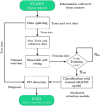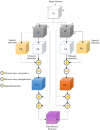Deep Learning-Based Prediction of Freezing of Gait in Parkinson's Disease With the Ensemble Channel Selection Approach
- PMID: 39740772
- PMCID: PMC11688057
- DOI: 10.1002/brb3.70206
Deep Learning-Based Prediction of Freezing of Gait in Parkinson's Disease With the Ensemble Channel Selection Approach
Abstract
Purpose: A debilitating and poorly understood symptom of Parkinson's disease (PD) is freezing of gait (FoG), which increases the risk of falling. Clinical evaluations of FoG, relying on patients' subjective reports and manual examinations by specialists, are unreliable, and most detection methods are influenced by subject-specific factors.
Method: To address this, we developed a novel algorithm for detecting FoG events based on movement signals. To enhance efficiency, we propose a novel architecture integrating a bottleneck attention module into a standard bidirectional long short-term memory network (BiLSTM). This architecture, adaptable to a convolution bottleneck attention-BiLSTM (CBA-BiLSTM), classifies signals using data from ankle, leg, and trunk sensors.
Finding: Given three movement directions from three locations, we reduce computational complexity in two phases: selecting optimal channels through ensemble learning followed by feature reduction using attention mapping. In FoG event detection tests, performance improved significantly compared to control groups and existing methods, achieving 99.88% accuracy with only two channels.
Conclusion: The reduced computational complexity enables real-time monitoring. Our approach demonstrates substantial improvements in classification results compared to traditional deep learning methods.
Keywords: Parkinson's disease; bidirectional long short‐term memory; bottleneck attention module; channel selection; ensembling; freezing of gait.
© 2024 The Author(s). Brain and Behavior published by Wiley Periodicals LLC.
Conflict of interest statement
The authors declare no conflicts of interest.
Figures











Similar articles
-
Freezing of Gait Detection in Parkinson's Disease: A Subject-Independent Detector Using Anomaly Scores.IEEE Trans Biomed Eng. 2017 Nov;64(11):2719-2728. doi: 10.1109/TBME.2017.2665438. IEEE Trans Biomed Eng. 2017. PMID: 28186875
-
Prediction of Freezing of Gait in Parkinson's disease based on multi-channel time-series neural network.Artif Intell Med. 2024 Aug;154:102932. doi: 10.1016/j.artmed.2024.102932. Epub 2024 Jul 6. Artif Intell Med. 2024. PMID: 39004005
-
Prediction of Freezing of Gait in Parkinson's Disease Using Wearables and Machine Learning.Sensors (Basel). 2021 Jan 17;21(2):614. doi: 10.3390/s21020614. Sensors (Basel). 2021. PMID: 33477323 Free PMC article.
-
Wearable-Sensor-based Detection and Prediction of Freezing of Gait in Parkinson's Disease: A Review.Sensors (Basel). 2019 Nov 24;19(23):5141. doi: 10.3390/s19235141. Sensors (Basel). 2019. PMID: 31771246 Free PMC article. Review.
-
Detection and prediction of freezing of gait with wearable sensors in Parkinson's disease.Neurol Sci. 2024 Feb;45(2):431-453. doi: 10.1007/s10072-023-07017-y. Epub 2023 Oct 16. Neurol Sci. 2024. PMID: 37843692 Review.
Cited by
-
Enhancing parkinson disease detection through feature based deep learning with autoencoders and neural networks.Sci Rep. 2025 Mar 13;15(1):8624. doi: 10.1038/s41598-025-88293-w. Sci Rep. 2025. PMID: 40075106 Free PMC article.
References
-
- Ashour, A. S. , El‐Attar A., Dey N., Abd El‐Kader H., and Abd El‐Naby M. M.. 2020. “Long Short Term Memory Based Patient‐dependent Model for FoG Detection in Parkinson's Disease.” Pattern Recognition Letters 131: 23–29. 10.1016/j.patrec.2019.11.036. - DOI
-
- Assam, R. , and Seidl T.. 2014. “Prediction of Freezing of Gait From Parkinson's Disease Movement Time Series Using Conditional Random Fields.” In Proceedings of the Third ACM SIGSPATIAL International Workshop on the Use of GIS in Public Health, 11–20. New York: ACM. 10.1145/2676629.2676630. - DOI
-
- Aşuroğlu, T. , Açıcı K., Erdaş Ç. B., Toprak M. K., Erdem H., and Oğul H.. 2018. “Parkinson's Disease Monitoring From Gait Analysis via Foot‐Worn Sensors.” Biocybernetics and Biomedical Engineering 38, no. 3: 760–772. 10.1016/j.bbe.2018.06.002. - DOI
MeSH terms
LinkOut - more resources
Full Text Sources
Medical

